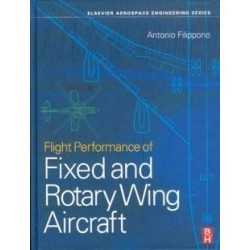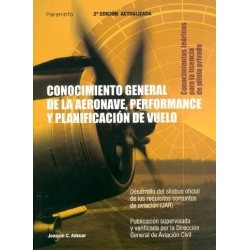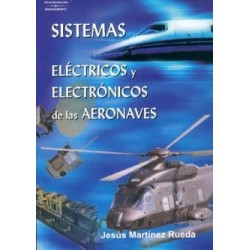
FLIGHT PERFORMANCE OF FIXED AND ROTARY WING AIRCRAFT.
- Calculation and optimisation of flight performance is required to design or select new aircraft, efficiently operate existing aircraft, and upgrade aircraft. It provides critical data for aircraft certification, accident investigation, fleet management, flight regulations and safety. This book presents an unrivalled range of advanced flight performance models for both transport and military aircraft, including the unconventional ends of the envelopes. Topics covered include the numerical solution of supersonic acceleration, transient roll, optimal climb of propeller aircraft, propeller performance, long-range flight with en-route stop, fuel planning, zero-gravity flight in the atmosphere, VSTOL operations, ski jump from aircraft carrier, optimal flight paths at subsonic and supersonic speed, range-payload analysis of fixed- and rotary wing aircraft, performance of tandem helicopters, lower-bound noise estimation, sonic boom, and more. This book will be a valuable text for undergraduate and post-graduate level students of aerospace engineering. It will also be an essential reference and resource for practicing aircraft engineers, aircraft operations managers and organizations handling air traffic control, flight and flying regulations, standards, safety, environment, and the complex financial aspects of flying aircraft.
- Audience:
Undergraduate & graduate students in aerospace & aeronautical engineering: Practicing aircraft engineers, fleet and operations managers: Organizations dealing with air traffic, regulations, standards, safety, environment & various financial aspects of the design & operation of the aircraft: Flight mechanics, those involved with aircraft design, scheduling, operations research, systems, controls, navigation, air traffic operations, optimisation & optimal control
- Contents:
Preface Acknowledgements List of tables Nomenclature: organizations Nomenclature: acronyms Nomenclature: main symbols Nomenclature: Greek symbols Nomenclature: subscripts/superscripts Supplements to the text Part I Fixed-Wing Aircraft Performance 1 Introduction 1.1 Physical units used 1.2 Performance parameters 1.3 Performance optimisation 1.4 Certificate of airworthiness 1.5 Upgrading of aircraft performance 1.6 Mission profiles Problems 2 The aircraft and its environment 2.1 General aircraft model 2.2 Reference systems 2.3 Forces on the aircraft 2.4 Moments of inertia 2.5 Flight dynamics equations 2.6 The international standard atmosphere 2.7 Non standard conditions Problems 3 Weight performance 3.1 The aircraft?s weight 3.2 Definitions of weights 3.3 Weight estimation 3.4 Weight management 3.5 Range-payload diagram 3.6 Direct operating costs Problems 4 Aerodynamic performance 4.1 Aerodynamic forces 4.2 Lift equation 4.3 Vortex lift 4.4 High-life systems 4.5 Drag equation 4.6 Glide ratio 4.7 Glide ratio at transonic and supersonic speed 4.8 Practical estimation of the drag coefficient 4.9 Compressibility effects 4.10 Transonic drag rise 4.11 Life and transonic buffet 4.12 Aero-thermodynamic heating 4.13 Aerodynamic penetration and radius 4.14 Aircraft vortex wakes 4.15 Aerodynamics and performance Problems 5 Engine performance 5.1 Gas turbine engines 5.2 Internal combustion engines 5.3 Engines flight envelopes 5.4 Power and thrust definitions 5.5 Generalised engine performance 5.6 Fuel flow 5.7 Propulsive efficiency 5.8 Thrust characteristics 5.9 Propeller characteristics Problems 6 Flight envelopes 6.1 General definitions 6.2 Aircraft speed range 6.3 Definition of speeds 6.4 Steady state level flight 6.5 Speed in level flight 6.6 Absolute ceiling of jet aircraft 6.7 Absolute ceiling of propeller aircraft 6.8 Optimal speeds for level flight 6.9 General flight envelopes 6.10 Limiting factors on flight envelopes 6.11 Dash speed of supersonic aircraft 6.12 Absolute ceiling of supersonic aircraft 6.13 Supersonic acceleration Problems 7 Take-off and landing 7.1 Definition of terminal phases 7.2 Conventional take-off 7.3 Ground run of jet aircraft 7.4 Solutions of the take-off equation 7.5 Rotation and initial climb 7.6 Take-off with one engine inoperative 7.7 Calculation of the balanced field length 7.8 Ground run of propeller aircraft 7.9 WAT charts 7.10 Missed take-off 7.11 Final approach and landing 7.12 Landing run 7.13 Effects of the wind 7.14 Ground manoeuvring Problems 8 Climb and gliding 8.1 Governing equations 8.2 Rate of climb 8.3 Steady climb of propeller airplane 8.4 Climb of jet airplane 8.5 Polar diagram for rate of climb 8.6 Energy methods 8.7 Specific excess power diagrams 8.8 Differential excess power plots 8.9 Minimum problems with energy method 8.10 Steady state gliding 8.11 General gliding flight 8.12 Maximum glide range with energy method 8.13 Minimum flight paths 8.14 Additional research on aircraft climb Problems 9 Cruise performance 9.1 Importance of the cruise flight 9.2 General definitions 9.3 Point performance 9.4 The Breguet range equation 9.5 Subsonic cruise of jet aircraft 9.6 Mission fuel 9.7 Cruise with intermediate stop 9.8 Aircraft selection 9.9 Supersonic cruise 9.10 Cruise range of propeller aircraft 9.11 Endurance 9.12 Effect of weight on cruise range 9.13 Effect of the wind on cruise range 9.14 Additional research on aircraft cruise 9.15 Formation flight Problems 10 Manoeuvre performance 10.1 Banked level turns 10.2 Banked turn at constant thrust 10.3 Power requirements 10.4 Effect of weight on turn radius 10.5 Manoeuvre envelope: n-V diagram 10.6 Turn rates 10.7 Sustainable g-loads 10.8 Unpowered turn 10.9 Soaring flight 10.10 Roll performance 10.11 Aircraft control under thrust asymmetry 10.12 Pull-up manoeuvre and the loop 10.13 Zero-gravity atmospheric flight 10.14 Flight path to a moving target Problems Part II Rotary-Wing Aircraft Performance 11 Rotorcraft performance 11.1 Fundamentals 11.2 Helicopter configurations 11.3 Mission profiles 11.4 Flight envelopes 11.5 Definitions and reference systems 11.6 Non dimensional parameters 11.7 Methods for performance calculations Problems 12 Rotorcraft in vertical flight 12.1 Hover performance 12.2 Effect of blade twist 12.3 Non dimensional hover performance 12.4 Vertical climb 12.5 Ceiling performance 12.6 Ground effect 12.7 Vertical descent 12.8 Hover endurance Problems 13 Rotorcraft in forward flight 13.1 Asymmetry of rotor loads 13.2 Power requirements 13.3 Rotor disk angle 13.4 Calculation of forward flight power 13.5 L/D of the helicopter 13.6 Forward flight analysis 13.7 Propulsive efficiency 13.8 Climb performance 13.9 Performance of tandem helicopters 13.10 Single or tandem helicopter? Problems 14 Rotorcraft manoeuvre 14.1 Limits on flight envelopes 14.2 Kinetic energy of the rotor 14.3 Autorotative index 14.4 Autorotative performance 14.5 Height-velocity diagram 14.6 The vortex ring state 14.7 Take-off and landing 14.8 Turn performance 14.9 Power required for turning 14.10 More on tail rotor performance Problems 15 Rotorcraft mission analysis 15.1 Specific air range 15.2 Non dimensional analysis of the SAR 15.3 Endurance and specific endurance 15.4 Speed for minimum power 15.5 Speed for maximum range 15.6 Fuel to climb 15.7 Payload-range diagram 15.8 Comparative payload fraction 15.9 Mission analysis Problems Part III 16 V/STOL performance 16.1 Hover characteristics 16.2 Jet-induced lift 16.3 Life augmentation 16.4 Calculation of short take-off 16.5 Ski jump 16.6 Convertiplanes or tilt-rotors 16.7 VSTOL flight envelopes Problems 17 Noise performance 17.1 Definitions of sound and noise 17.2 Trends in noise reduction 17.3 Airframe noise of fixed-wing aircraft 17.4 Engine noise 17.5 Noise certification procedure 17.6 Noise reduction from operations 17.7 Minimum noise to climb 17.8 Helicopter noise 17.9 Helicopter noise reduction 17.10 Noise certification of civil helicopters 17.11 Sonic boom Problems Appendix A Aircraft models A.1 Aircraft A: subsonic commercial jet A.2 Aircraft B: turboprop aircraft A.3 Aircraft C: supersonic jet fighter A.4 Aircraft D: civil transport helicopter A.5 Aircraft E: tandem helicopter Appendix B Noise-data Appendix C Selected simulation programs C.1 Assembling aircraft forces C.2 Calculation of numerical derivatives C.3 Optimal climb of fighter jet aircraft C.4 Optimal climb rate of turboprop C.5 Calculation of mission fuel C.6 Supersonic acceleration C.7 Asymmetric thrust control C.8 Hover power with blade element theory C.9 Forward flight power of helicopter.






